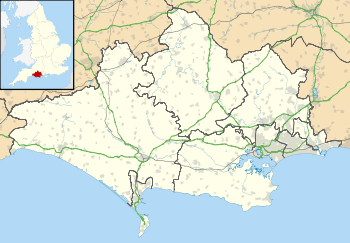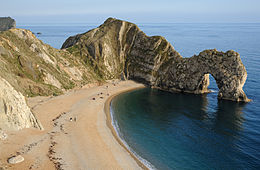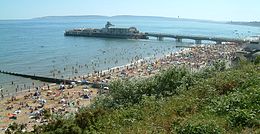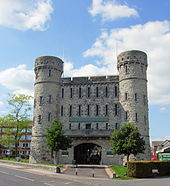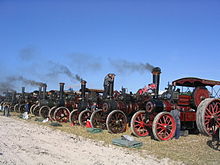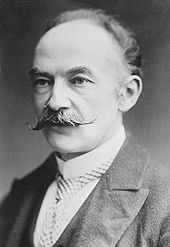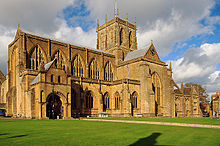
Dorset
Did you know...
This Schools selection was originally chosen by SOS Children for schools in the developing world without internet access. It is available as a intranet download. SOS Child sponsorship is cool!
| Dorset | |
|---|---|
 Flag of Dorset |
|
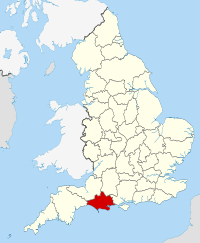 |
|
| Geography | |
| Status | Ceremonial and (smaller) non-metropolitan county |
| Origin | Historic |
| Region | South West England |
| Area - Total |
Ranked 20th 2,653 km2 (1,024 sq mi) |
| ISO 3166-2 | GB-DOR (Dorset) GB-POL (Poole) GB-BMH (Bournemouth) |
| ONS code | 19 |
| NUTS 3 | UKK22 (Dorset) UKK21 (Poole and Bournemouth) |
| Demography | |
| Population - Total (2011 est.) - Density |
Ranked 31st 745,400 265 /km2 (690 /sq mi) |
| Ethnicity | 97.9% White |
| Politics | |
| Dorset County Council http://www.dorsetforyou.com/ Borough of Poole http://www.poole.gov.uk/ Bournemouth Borough Council http://www.bournemouth.gov.uk |
|
| Executive | Conservative |
| Members of Parliament | |
| Districts | |
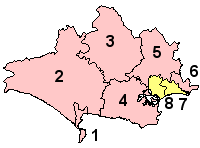
|
|
Dorset (pron.: / ˈ d ɔr s ɨ t /) (or archaically, Dorsetshire), is a county in South West England on the English Channel coast. The ceremonial county comprises the non-metropolitan county, which is governed by Dorset County Council, and the unitary authorities of Poole and Bournemouth. Covering an area of 2,653 square kilometres (1,024 sq mi), Dorset borders Devon to the west, Somerset to the north-west, Wiltshire to the north-east, and Hampshire to the east. The county town is Dorchester which is situated in the south. After the reorganisation of local government in 1974 the county's border was extended eastward to incorporate the Hampshire towns of Bournemouth and Christchurch. Around half of the population lives in the South East Dorset conurbation, while the rest of the county is largely rural with a low population density.
The county has a long history of human settlement stretching back to the Neolithic era. The Romans conquered Dorset's indigenous Celtic tribe, and during the early Middle Ages, the Saxons settled the area and made Dorset a shire in the 7th century. The first recorded Viking raid on the British Isles occurred in Dorset during the 8th century and the black death entered England at Melcombe Regis in 1348. Dorset has seen much civil unrest: during the English Civil War an uprising of vigilantes was crushed by Cromwell's forces in a pitched battle near Shaftesbury; the Duke of Monmouth's doomed rebellion began at Lyme Regis; and a group of farm labourers from Tolpuddle were instrumental in the formation of the trade union movement. During the Second World War, Dorset was heavily involved in the preparations for the invasion of Normandy and the large harbours of Portland and Poole were two of the main embarkation points on D-Day.
Dorset has a varied landscape featuring broad elevated chalk downs, steep limestone ridges and low-lying clay valleys. Over half the county is designated as an Area of Outstanding Natural Beauty and three-quarters of its coastline is a World Heritage Site that features notable landforms such as Lulworth Cove, the Isle of Portland, Chesil Beach and Durdle Door. Agriculture was traditionally the major industry of Dorset but is now in decline and tourism has become increasingly important to the economy. There are no motorways in Dorset but a network of A roads cross the county and two railway main lines connect to London. Dorset has ports at Poole, Weymouth and Portland and an international airport. The county has a variety of museums, theatres and festivals, and is host to one of Europe's largest outdoor shows. It is the birthplace of Thomas Hardy, who used the county as the principal setting of his novels, and William Barnes, whose poetry celebrates the ancient Dorset dialect.
Toponymy
Dorset derives its name from the county town of Dorchester. The Romans established the settlement in the 1st century and named it Durnovaria which was a Latinised version of a Brythonic word possibly meaning "place with fist-sized pebbles". The Saxons named the town Dornwaraceaster (the suffix "ceaster" being the Old English name for a Roman town) and Dornsæte came into use as the name for the inhabitants of the area from "Dorn"—a reduced form of Dornwaraceaster—and the Old English word "sæte" meaning people. It is first mentioned in the Anglo-Saxon Chronicle in AD 845 and in the 10th century the county's archaic name, "Dorseteschyre" (Dorsetshire), was first recorded.
History
The first human visitors to Dorset were Mesolithic hunters, from around 8000 BC. The first permanent Neolithic settlers appeared around 3000 BC and were responsible for the creation of the Dorset Cursus, a 10.5-kilometre (6.5 mi) long monument constructed for ritual or ceremonial purposes. From 2800 BC onwards Bronze Age farmers cleared Dorset's woodlands for agricultural use and Dorset's high chalk hills provided a location for numerous round barrows. During the Iron Age, Celtic immigrants known as the Durotriges established a series of hill forts across the county—most notably Maiden Castle which is one of the largest in Europe.
The Romans arrived in Dorset during their conquest of Britain in AD 43. Maiden Castle was captured by a Roman legion under the command of Vespasian, and the Roman settlement of Durnovaria was established nearby. Bokerley Dyke, a large defensive ditch built by the county's post-Roman inhabitants near the border with modern-day Hampshire, delayed the advance of the Saxons into Dorset for almost 150 years. However, by the end of the 7th century Dorset had fallen under Saxon control and been incorporated into the Kingdom of Wessex. The Saxons established a diocese at Sherborne and Dorset was made a shire—an administrative district of Wessex and predecessor to the English county system—with borders that have changed little since. In 789 the first recorded Viking attack on the British Isles took place in Dorset on the Portland coast, and they continued to raid into the county for the next two centuries.
After the Norman Conquest in 1066, feudal rule was established in Dorset and the bulk of the land was divided between the Crown and ecclesiastical institutions. The Normans consolidated their control over the area by constructing castles at Corfe, Wareham and Dorchester in the early part of the 12th century. Over the next 200 years Dorset's population grew substantially and additional land was enclosed for farming to provide the extra food required. The wool trade, the quarrying of Purbeck Marble and the busy ports of Weymouth, Melcombe Regis, Lyme Regis and Bridport brought prosperity to the county. However, Dorset was devastated by the bubonic plague in 1348 which arrived in Melcombe Regis on a ship from Gascony. The disease, more commonly known as the Black Death, created an epidemic that spread rapidly and wiped out a third of the population of the country.
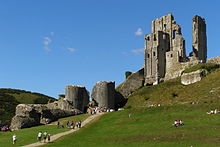
The dissolution of the monasteries (1536–1541) met little resistance in Dorset and many of the county's abbeys, including Shaftesbury, Cerne and Milton, were sold to private owners. In 1642, at the commencement of the English Civil War, the Royalists took control of the entire county apart from Poole and Lyme Regis. However, within three years their gains had been almost entirely reversed by the Parliamentarians. An uprising of Clubmen—vigilantes weary of the depredations of the war—took place in Dorset in 1645. Some 2,000 of these rebels offered battle to Lord Fairfax's Parliamentary army at Hambledon Hill but they were easily routed. Sherborne Castle was taken by Fairfax that same year and in 1646 Corfe Castle, the last remaining Royalist stronghold in Dorset, was captured after an act of betrayal: both were subsequently slighted. The Duke of Monmouth's unsuccessful attempt to overthrow James II began when he landed at Lyme Regis in 1665. A series of trials known as the Bloody Assizes took place to punish the rebels. Over a five-day period in Dorchester, Judge Jeffreys presided over 312 cases: 74 of the accused were executed, 175 were transported, and nine were publicly whipped. In 1686, at Charborough Park, a meeting took place to plot the downfall of James II of England. This meeting was effectively the start of the Glorious Revolution.
During the 18th century, much smuggling took place along the Dorset coast; its coves, caves and sandy beaches provided opportunities for gangs such as the Hawkhursts to stealthily bring smuggled goods ashore. Poole became Dorset's busiest port and established prosperous trade links with the fisheries of Newfoundland which supported cloth, rope and net manufacturing industries in the surrounding towns and villages. However, the industrial revolution largely bypassed Dorset which lacked coal resources and as a consequence the county remained predominantly agricultural. Farming has always been central to the economy of Dorset and the county became the birthplace of the modern trade union movement when, in 1834, six farm labourers formed a union to protest against falling wages. The labourers, who are now known as the Tolpuddle Martyrs, were subsequently arrested for administering "unlawful oaths" and sentenced to transportation but they were pardoned following massive protests by the working classes.
The Dorsetshire Regiment were the first British unit to face a gas attack during the First World War (1914–1918) and they sustained particularly heavy losses at the Battle of the Somme. In total some 4,500 Dorset servicemen died in the war and of the county's towns and villages, only one, Langton Herring, known as a Thankful Village, had no residents killed. During the Second World War (1939–1945) Dorset was heavily involved in the preparations for the invasion of Normandy: beach landing exercises were carried out at Studland and Weymouth and the village of Tyneham was requisitioned for army training. Tens-of-thousands of troops departed Weymouth, Portland and Poole harbours during D-Day and gliders from RAF Tarrant Rushton dropped troops near Caen to begin Operation Tonga. Dorset experienced an increase in holiday-makers after the war. First popularised as a tourist destination by George III's frequent visits to Weymouth, the county's coastline, seaside resorts and its sparsely populated rural areas attract millions of visitors each year. With farming declining across the country, tourism has edged ahead as the primary revenue-earning sector.
Settlements
Dorset is largely rural with many small villages, few large towns and no cities. The only major urban area is the South East Dorset conurbation, which is situated at the south-eastern end of the county and is atypical of the county as a whole. It consists of the seaside resort of Bournemouth, the historic port and borough of Poole, the towns of Christchurch and Ferndown plus many surrounding villages. Bournemouth, the most populous town in the conurbation, was established in the Georgian era when sea bathing became popular. Poole, the second largest settlement (once the largest town in the county), adjoins Bournemouth to the west and contains the suburb of Sandbanks which has some of the highest land values by area in the world.
The other two major settlements in the county are Dorchester, which has been the county town since at least 1305, and Weymouth, a major seaside resort since the 18th century. Blandford Forum, Sherborne, Gillingham, Shaftesbury and Sturminster Newton are historic market towns which serve the farms and villages of the Blackmore Vale in north Dorset. Beaminster and Bridport are situated in the west of the county; Verwood and the historic Saxon market towns of Wareham and Wimborne Minster are located to the east. Lyme Regis and Swanage are small coastal towns popular with tourists. Under construction on the western edge of Dorchester is the experimental new town of Poundbury commissioned and co-designed by Prince Charles. The suburb, which is expected to be fully completed by 2025, was designed to integrate residential and retail buildings and counter the growth of dormitory towns and car-oriented development.
Physical geography
Dorset covers an area of 2,653 square kilometres (1,024 sq mi) and contains considerable variety in its underlying geology, which is partly responsible for the diversity of landscape. A large percentage (66%) of the county comprises either chalk, clay or mixed sand and gravels. The remainder is less straightforward and includes Portland and Purbeck stone, other limestones, calcareous clays and shales. Portland and Purbeck stone are of national importance as a building material and for restoring some of Britain's most famous landmarks. Almost every type of rock known from the Early Jurassic to the Eocene epochs can be found in the county.
Dorset has a number of limestone ridges which are mostly covered in either arable fields or calcareous grassland supporting sheep. These limestone areas include a wide band of Cretaceous chalk which crosses the county as a range of hills from north-east to south-west, incorporating Cranborne Chase and the Dorset Downs, and a narrow band running from south-west to south-east, incorporating the Purbeck Hills. Between the chalk hills are large, wide vales and wide flood plains. These vales are dotted with small villages, farms and coppices, and include the Blackmore Vale ( Stour valley) and Frome valley. The Blackmore Vale is composed of older Jurassic deposits, largely clays interspersed with limestones, and has traditionally been a centre for dairy agriculture. South-east Dorset, including the lower Frome valley and around Poole and Bournemouth, comprises younger Eocene deposits, mainly sands and clays of poor agricultural quality. The soils created from these deposits support a heathland habitat which sustains all six native British reptile species. Most of the Dorset heathland has Site of Special Scientific Interest (SSSI) status with three areas designated as internationally important Ramsar sites. In the far west of the county and along the coast there are frequent changes in rock strata, which appear in a less obviously sequential way compared to the landscapes of the chalk and the heath. In the west this results in a hilly landscape of diverse character that resembles that of neighbouring county Devon. Marshwood Vale, a valley of Lower Lias clay at the western tip of the county, lies to the south of the two highest points in Dorset: Lewesdon Hill at 279 metres (915 ft) and Pilsdon Pen at 277 metres (909 ft).
A former river valley flooded by rising sea levels 6,000 years ago, Poole Harbour is one of the largest natural harbours in the world. The harbour is very shallow in places and contains a number of islands, notably Brownsea Island, the birthplace of the Scouting movement and one of the few remaining sanctuaries for indigenous red squirrels in England. The harbour, and the chalk and limestone hills of the Isle of Purbeck to the south, lie atop Western Europe's largest onshore oil field. The field, operated by Perenco from Wytch Farm, has the world's oldest continuously pumping well at Kimmeridge which has been producing oil since the early 1960s.
Dorset's diverse geography ensures it has an assortment of rivers, although a moderate annual rainfall coupled with rolling hills, means most are typically lowland in nature. Much of the county drains into three rivers, the Frome, Piddle and Stour which all flow to the sea in a south-easterly direction. The Frome and Piddle are chalk streams but the Stour, which rises in Wiltshire to the north, has its origins in clay soil. The River Avon, which flows mainly through Wiltshire and Hampshire, enters Dorset towards the end of its journey at Christchurch Harbour. The rivers Axe and Yeo, which principally drain the counties of Devon and Somerset respectively, have their sources in the north-west of the county. In the south-west, a number of small rivers run into the sea along the Dorset coastline; most notable of these are the Char, Brit, Bride and Wey.
Most of Dorset's coastline is part of the Jurassic Coast, a World Heritage Site, which stretches for 155 kilometres (96 mi) between Studland and Exmouth in Devon. This coast documents the entire Mesozoic era, from Triassic to Cretaceous and is noted for its geological landforms. The Dorset section has yielded important fossils, including Jurassic trees and the first complete Ichthyosaur, discovered near Lyme Regis in 1811 by Mary Anning. The county features some notable coastal landforms, including examples of a cove ( Lulworth Cove), a natural arch ( Durdle Door) and chalk stacks ( Old Harry Rocks). Jutting out into the English Channel at roughly the midpoint of the Dorset coastline is the Isle of Portland, a limestone island that is connected to the mainland by Chesil Beach, a 27-kilometre (17 mi) long shingle barrier beach protecting Britain's largest tidal lagoon.
The county has one of the highest proportions of conservation areas in England—including two Areas of Outstanding Natural Beauty which together cover 53% of the county. It has two Heritage Coasts totalling 92 kilometres (57 mi) and Sites of Special Scientific Interest covering 199 km2 (77 sq mi). The South West Coast Path, a National Trail, runs along the Dorset coast from the Devon boundary to South Haven Point near Poole.
Climate
Dorset's climate of warm summers and mild winters is partly due to its position on Britain's south coast. The third most southerly county in the UK, Dorset is less affected by the more intense Atlantic winds than Cornwall and Devon. Dorset, along with the entire south-west, has higher winter temperatures, average 4.5 to 8.7 °C (40 to 48 °F), than the rest of the United Kingdom. However, Dorset maintains higher summer temperatures than Devon and Cornwall, with average highs of 19.1 to 22.2 °C (66 to 72 °F). Excluding hills such as the Dorset Downs, the average annual temperature of the county is 9.8 to 12 °C (50 to 54 °F).
The south coast counties of Dorset, Hampshire, West Sussex, East Sussex and Kent enjoy more sunshine than anywhere else in the United Kingdom, receiving 1,541–1,885 hours a year. Average annual rainfall varies across the county—southern and eastern coastal areas receive as little as 741 millimetres (29.2 in) per year; the Dorset Downs receive between 1,061 and 1,290 millimetres (41.7 to 50.8 in) per year; less than Devon and Cornwall to the west but more than counties to the east.
| Weymouth climatic averages | ||||||||||||||
|---|---|---|---|---|---|---|---|---|---|---|---|---|---|---|
| Month | Jan | Feb | Mar | Apr | May | Jun | Jul | Aug | Sep | Oct | Nov | Dec | Year | |
| Average maximum temperature; °C (°F) |
8.6 (47.5) |
8.4 (47.1) |
10.2 (50.4) |
12.3 (54.1) |
15.3 (59.5) |
17.7 (63.9) |
19.7 (67.5) |
20.1 (68.2) |
18.4 (65.1) |
15.2 (59.4) |
11.8 (53.2) |
9.2 (48.6) |
13.9 (57.0) |
|
| Average mean temperature; °C (°F) |
6.4 (43.5) |
6.1 (43.0) |
7.6 (45.7) |
9.3 (48.7) |
12.2 (54.0) |
14.7 (58.5) |
16.8 (62.2) |
17.1 (62.8) |
15.5 (59.9) |
12.7 (54.9) |
9.5 (49.1) |
6.9 (44.4) |
11.2 (52.2) |
|
| Average minimum temperature; °C (°F) |
4.1 (39.4) |
3.7 (39.7) |
4.9 (40.8) |
6.2 (43.2) |
9.1 (48.4) |
11.7 (53.1) |
13.9 (57.0) |
14.1 (57.4) |
12.5 (54.5) |
10.2 (50.4) |
7.2 (45.0) |
4.6 (40.3) |
8.5 (47.3) |
|
| Average sunshine hours; per month (per day) |
66.8 (2.2) |
91.1 (3.2) |
133.6 (4.3) |
200.3 (6.7) |
228.5 (7.4) |
229.1 (7.6) |
243.6 (7.9) |
227.7 (7.3) |
175.5 (5.9) |
126.3 (4.1) |
84.3 (2.8) |
62.9 (2.0) |
1869.8 (5.1) |
|
| Average sea temperature; °C (°F) |
7.8 (46.0) |
7.0 (44.6) |
7.5 (45.5) |
8.8 (47.8) |
11.0 (51.8) |
13.3 (55.9) |
15.8 (60.4) |
17.2 (63.0) |
16.7 (62.1) |
14.7 (58.5) |
12.3 (54.1) |
9.8 (49.6) |
11.8 (53.2) |
|
| Average rainfall; mm (inches) |
78.5 (3.09) |
58.3 (2.30) |
58.0 (2.28) |
49.4 (1.94) |
44.7 (1.76) |
40.2 (1.58) |
35.9 (1.41) |
50.0 (1.97) |
55.8 (2.20) |
85.3 (3.36) |
88.7 (3.49) |
85.5 (3.37) |
730.3 (28.75) |
|
| Days of rainfall ≥ 1 mm | 13.0 | 9.9 | 9.4 | 8.3 | 8.4 | 7.0 | 6.6 | 7.5 | 7.9 | 11.5 | 12.4 | 12.4 | 113.9 | |
| 1981–2010 averages for Wyke Regis climate station. Sources: Met Office and Cefas | ||||||||||||||
Demography
| UK Census 2001 | Dorsetnote |
Bournemouth |
Poole |
South West |
England |
||||||||||||||||||||||||
|---|---|---|---|---|---|---|---|---|---|---|---|---|---|---|---|---|---|---|---|---|---|---|---|---|---|---|---|---|---|
| Population | 390,980 | 163,444 | 138,288 | 4,928,434 | 49,138,831 | ||||||||||||||||||||||||
| White | 98.75% | 96.68% | 98.2% | 97.71% | 90.92% | ||||||||||||||||||||||||
| Mixed | 0.5% | 1.19% | 0.67% | 0.76% | 1.31% | ||||||||||||||||||||||||
| Asian | 0.25% | 0.7% | 0.52% | 0.67% | 4.57% | ||||||||||||||||||||||||
| Black | 0.15% | 0.42% | 0.18% | 0.43% | 2.3% | ||||||||||||||||||||||||
| Chinese or other | 0.37% | 1.01% | 0.43% | 0.45% | 0.89% | ||||||||||||||||||||||||
| Christian | 77.88% | 70.91% | 74.34% | 73.99% | 71.74% | ||||||||||||||||||||||||
| Non-Christian | 0.99% | 3.07% | 1.3% | 1.48% | 5.97% | ||||||||||||||||||||||||
| No religion | 13.74% | 17.94% | 16.23% | 16.75% | 14.59% | ||||||||||||||||||||||||
| Not stated | 7.39% | 8.08% | 8.03% | 7.79% | 7.69% | ||||||||||||||||||||||||
| ^ Excluding Bournemouth and Poole | |||||||||||||||||||||||||||||
The 2001 Census records Dorset's population as 692,712. This consisted of 390,980 for the non-metropolitan county (not including Bournemouth and Poole), 163,444 for the unitary authority of Bournemouth and 138,288 for the unitary authority of Poole. In 2009 it was estimated that the population had risen by around 2.5% to 710,100: 404,000 in the non-metropolitan county and 164,900 and 141,200 in Bournemouth and Poole respectively. The South East Dorset conurbation which comprises Poole, Bournemouth and Christchurch contains 62% of the population; the next largest urban area is Weymouth. The remainder of the county is largely rural with a relatively sparse population.
Dorset's population has a high proportion of older people and a lower than average proportion of young people: 26.7% are of retirement age, significantly higher than the England and Wales average of 19.5%, and 16.8% are less than 15 years old, lower than the England and Wales average of 18.7%. The working age population (females between 16 and 59 and males between 16 and 64) is lower than average at 56.5%. Average life expectancy in the county is 83.4 years for females and 79.3 years for males. This compares favourably with the averages for Great Britain of 81.6 and 77.3 years respectively. Around 97.93% of Dorset's population are of white ethnicity, 74.38% of the population are Christian and 15.94% say they are not religious.
The county has low birth rates at 9.1 births per 1,000 in 2010 compared to the England and Wales average of 13.1 per 1,000. It has a higher than average mortality rate at 11.6 deaths per 1,000 population (8.9 for England and Wales). In 2010 deaths exceeded births in the non-metropolitan county by 1,028; however between 1991 and 2010, more people moved into the county than out, and this contributed to an overall growth of the population by 12.2% (9.1% for England and Wales). This rate of growth is set to continue; a 12.7% population growth is predicted between 2008 and 2033. The unitary authorities of Bournemouth and Poole followed a similar pattern and only a net gain of migrants prevented a decline in the population. However, in Bournemouth in 2007, births began to exceed deaths and in 2010 there were 224 more births than deaths. Between 1998 and 2004 Poole borough experienced a decline in its population when there was a fall in the level of net migration. The trend has since been reversed and a continued increase in Poole's population has been predicted.
| Historical population of Dorset | |||||||||||
| Year | 1801 | 1811 | 1821 | 1831 | 1841 | 1851 | 1861 | 1871 | 1881 | 1891 | 1901 |
|---|---|---|---|---|---|---|---|---|---|---|---|
| Population | 101,857 | 112,930 | 129,210 | 143,443 | 161,617 | 169,699 | 174,255 | 178,813 | 183,371 | 188,700 | 188,263 |
| Year | 1911 | 1921 | 1931 | 1941 | 1951 | 1961 | 1971 | 1981 | 1991 | 2001 | 2011 |
| Population | 190,940 | 193,543 | 198,105 | 214,700 | 233,206 | 259,751 | 292,811 | 321,676 | 366,681 | 390,986 | - |
| Pre-1974 statistics were gathered from local government areas that now comprise Dorset Source: Great Britain Historical GIS. |
|||||||||||
Politics
Local government in Dorset consists of a county council ( Dorset County Council) and two unitary authorities ( Bournemouth Borough Council and the Borough of Poole). Dorset County Council was created by the Local Government Act 1888 to govern the newly created administrative county of Dorset which was based largely on the historic county borders. Dorset became a two-tier non-metropolitan county after a reorganisation of local government in 1974 and its border was extended eastwards to incorporate the former Hampshire towns of Bournemouth and Christchurch. Following a review by the Local Government Commission for England, Bournemouth and Poole each became administratively independent single-tier unitary authorities in 1997, although they remain part of the county geographically and for ceremonial purposes. The county council is based in Dorchester and comprises six second-tier districts: West Dorset, East Dorset, North Dorset, Purbeck, Christchurch, and Weymouth and Portland. The council is controlled by the Conservative Party: at the 2009 local elections 28 Conservative, 16 Liberal Democrat and one independent county councillors were elected. Bournemouth is also Conservative-controlled: the council comprises 46 Conservative, three Liberal Democrat, three Labour and two independent councillors. The Conservatives lost overall control of Poole at local elections in 2011 but subsequently formed a minority administration—the council comprises 21 Conservative councillors, 18 Liberal Democrat and three Poole People (a political party of Poole residents).
For representation in Parliament Dorset is divided into eight Parliamentary constituencies—five county constituencies and three borough constituencies. At the 2010 general election, the Conservative Party was dominant, strengthening their lead in six seats, and regaining one other from Labour. The borough constituencies of Bournemouth East, Bournemouth West and Poole are traditionally Conservative safe seats and are all represented by Conservative Members of Parliament. The county constituencies of North Dorset and Christchurch are also represented by Conservative MPs. West Dorset is represented by Conservative MP Oliver Letwin who is the Minister of State at the Cabinet Office. The marginal seat of South Dorset is represented by Richard Drax, who gained the seat from Dorset's only Labour representative, Jim Knight, in 2010. Mid Dorset and North Poole is held by Liberal Democrat MP Annette Brooke who retained her seat in 2010 with a slim majority of 269 (0.6% of the vote) over the Conservative candidate. For the European Parliament the county lies within the South West England constituency which elected three Conservative, two UK Independence Party and one Liberal Democrat Members of the European Parliament (MEPs) at the 2009 European Parliament election.
Economy and industry
| Industry | Dorset |
Poole |
Bournemouth |
Great Britain |
|||||||||||||||||||||||||
|---|---|---|---|---|---|---|---|---|---|---|---|---|---|---|---|---|---|---|---|---|---|---|---|---|---|---|---|---|---|
| Manufacturing | 11.9% | 15.8% | 3.2% | 10.2% | |||||||||||||||||||||||||
| Construction | 5.3% | 4.6% | 3.2% | 4.8% | |||||||||||||||||||||||||
| Services | 81.5% | 79% | 93.1% | 83.5% | |||||||||||||||||||||||||
| Tourism-related | 10.2% | 7.7% | 12% | 8.2% | |||||||||||||||||||||||||
|
A.^ Excludes self-employed, government-supported trainees and armed forces |
|||||||||||||||||||||||||||||
In 2003 the gross value added (GVA) for the non-metropolitan county was £4,673 million, with an additional £4,705 million for Poole and Bournemouth. Primary industry produced 2.03% of GVA, secondary industry produced 22.44% and 75.53% came from tertiary industry. The average GVA for the 16 regions of South West England was £4,693 million.
The principal industry in Dorset was once agriculture. It has not, however, been the largest employer since the mid 19th century as mechanisation substantially reduced the number of workers required. Agriculture has become less profitable and the industry has declined further. Within the administrative county between 1995 and 2003, GVA for primary industry (largely agriculture, fishing and quarrying) declined from £229 million to £188 million—7.1% to 4.0%. In 2007, 2,039 km2 (787 sq mi) of the county was in agricultural use, up from 1,986 km2 (767 sq mi) in 1989, although this was due to an increase in permanent grass, and land set aside. By contrast, in the same period, arable land decreased from 9,925 km2 (3,832 sq mi) to 9,157 km2 (3,536 sq mi). Excluding fowl, sheep are the most common animal stock in the county; between 1989 and 2006 their numbers fell from 252,189 to 193,500. Cattle and pig farming has declined similarly; during the same period the number of cattle fell from 240,413 to 170,700, and pigs from 169,636 to 72,700.
In 2009 there were 2,340 armed forces personnel stationed in Dorset including the Royal Armoured Corps at Bovington, Royal Signals at Blandford and the Royal Marines at Poole. The military presence has had a mixed effect on the local economy, bringing additional employment for civilians, but on occasion having a negative impact on the tourist trade, particularly when popular areas are closed for military manoeuvres. Plans to relocate the Royal School of Signals from Blandford to South Wales could result in a loss of up to £74 million GVA for the area.
Other major employers in the county include: BAE Systems, Sunseeker International, J.P. Morgan, Cobham plc and Bournemouth University. Dorset's three ports, Poole, Weymouth and Portland, and the smaller harbours of Christchurch, Swanage, Lyme Regis, Wareham and West Bay generate a substantial amount of international trade and tourism. Around 230 fishing vessels that predominantly catch crab and lobster are based in Dorset's ports. When the waters around Weymouth and Portland were chosen for the sailing events in the 2012 Summer Olympic Games, the area underwent an increased investment in infrastructure and a growth in the marine leisure sector. It is expected that this will continue to have a positive effect on local businesses and tourism.
Tourism has grown in Dorset since the late 18th century and is now the predominant industry. It is estimated that 37,500 people work in Dorset's tourism sector. Some 3.2 million British and 326,000 foreign tourists visited the county in 2008, staying a total of 15.1 million nights. In addition there were 14.6 million day visitors. The combined spending of both groups was £1,458 million. Towns received 56% of Dorset's day trippers, 27% went to the coast and 17% to the countryside. A survey carried out in 1997 concluded that the primary reason tourists were drawn to Dorset was the attractiveness of the county's coast and countryside. Numbers of domestic and foreign tourists have fluctuated in recent years due to various factors including security and economic downturn, a trend reflected throughout the UK.
Manufacturing industry in Dorset provided 10.3% of employment in 2008. This was slightly above the average for Great Britain but below that of the South West region which was at 10.7% for that period. The sector is the county's fourth largest employer, but a predicted decline suggests there will be 10,200 fewer jobs in manufacturing by 2026.
Culture
As a largely rural county, Dorset has fewer major cultural institutions than larger or more densely populated areas. Major venues for concerts and theatre include Poole's Lighthouse arts centre, Bournemouth's BIC, Pavilion Theatre and O2 Academy, and the Pavilion theatre in Weymouth. One of Dorset's most noted cultural institutions is the Bournemouth Symphony Orchestra which was founded in 1893. Based in Poole, the orchestra performs over 130 concerts across southern England each year.
Dorset has more than 30 general and specialist museums. The Dorset County Museum in Dorchester was founded in 1846 and contains an extensive collection of exhibits covering the county's history and environment. The Tank Museum at Bovington contains more than 300 tanks and armoured vehicles from 30 nations. The museum is the largest in Dorset and its collection has been designated of national importance. Other museums which reflect the cultural heritage of the county include The Keep Military Museum in Dorchester, the Russell-Cotes Museum in Bournemouth, the Charmouth Heritage Coast Centre, Poole Museum, Portland Museum and Wareham Town Museum.
Dorset contains 190 Conservation Areas, more than 1,500 Scheduled Ancient Monuments, over 30 registered parks and gardens and 12,850 listed buildings. Grade I listed buildings include: Portland Castle, a coastal fort commissioned by Henry VIII; a castle with more than a 1,000 years of history at Corfe; a Roman ruin described by English Heritage as the "only Roman town house visible in Britain"; Athelhampton, a Tudor manor house; Forde Abbey, a stately home and former Cistercian monastery; Christchurch Priory, the longest church in England; and St Edwold's church, one of the smallest.
Dorset hosts a number of annual festivals, fairs and events including the Great Dorset Steam Fair near Blandford, one of the largest events of its kind in Europe, and the Bournemouth Air Festival, a free air show that attracted 1.3 million visitors in 2009. The Spirit of the Seas is a maritime festival held in Weymouth and Portland. Launched in 2008, the festival features sporting activities, cultural events and local entertainers. The Dorset County Show, which was first held in 1841, is a celebration of Dorset's agriculture. The two-day event exhibits local produce and livestock and attracts some 55,000 people. In addition to the smaller folk festivals held in towns such as Christchurch and Wimborne, Dorset holds several larger musical events such as Camp Bestival, Endorse It In Dorset, End of the Road and the Larmer Tree Festival.
Dorset's only Football League club is A.F.C. Bournemouth, which plays in League One—the third highest division in the English football league system. Non-League semi-professional teams in the county include Conference South team Dorchester Town F.C. and Southern Premier Division team Weymouth F.C.. Dorset County Cricket Club competes in the Minor Counties Cricket Championship and is based at Dean Park Cricket Ground in Bournemouth. Poole Stadium hosts regular greyhound racing and is the home to top-flight speedway team Poole Pirates. The county's coastline, on the English Channel, is noted for its watersports which take advantage of the sheltered waters in the bays of Weymouth and Poole, and the harbours of Poole and Portland. Dorset hosted the sailing events at the 2012 Summer Olympics and 2012 Summer Paralympics at the Weymouth and Portland National Sailing Academy in Portland Harbour. The venue was completed in May 2009 and was used by international sailing teams in preparation for the Games.
Dorset is famed in literature for being the native county of author and poet Thomas Hardy, and many of the places he describes in his novels in the fictional Wessex are in Dorset, which he renamed South Wessex. The National Trust owns Thomas Hardy's Cottage, in Higher Bockhampton, east of Dorchester; and Max Gate, his former house in Dorchester. Several other writers have called Dorset home, including Douglas Adams, who wrote much of The Hitchhiker's Guide to the Galaxy while he lived in Stalbridge; John le Carré, author of espionage novels, was born in Poole; Tom Sharpe of Wilt fame lived in Bridport; John Fowles ( The French Lieutenant's Woman) lived in Lyme Regis before he died in late 2005; T.F. Powys lived in Chaldon Herring for over 20 years and used it as inspiration for the fictitious village of Folly Down in his novel Mr. Weston's Good Wine; John Cowper Powys, his elder brother, also set a number of his works in Dorset, such as the novels Maiden Castle and Weymouth Sands. The 19th century poet William Barnes was born in Bagber and wrote many poems in his native Dorset dialect. Originating from the ancient Norse and Saxon languages, the dialect was prevalent across the Blackmore Vale but has fallen into disuse.
Dorset's flag, which is known as the Dorset Cross or St Wite's Cross, was adopted in 2008 following a public competition organised by Dorset County Council. The winning design, which features a white cross with a red border on a golden background, attracted 54% of the vote. All three colours are used in Dorset County Council's coat of arms and the red and white was used in recognition of the English flag. The golden colour represents Dorset's sandy beaches and the Dorset landmarks of Golden Cap and Gold Hill. It is also a reference to the Wessex Dragon, a symbol of the Saxon Kingdom which Dorset once belonged to, and the gold wreath featured on the badge of the Dorset Regiment.
Transport
Dorset is connected to London by two main line railways. The West of England Main Line runs through the north of the county at Gillingham and Sherborne. Running west from London Waterloo to Exeter St Davids in Devon, it provides a service for those who live in the western districts of Dorset. The South Western Main Line runs through the south at Bournemouth, Poole, Dorchester and the terminus at Weymouth. Additionally, the Heart of Wessex Line runs north from Weymouth to Bristol and the Swanage Railway, a heritage steam and diesel railway, runs the 10 kilometres (6 mi) between Norden and Swanage.
Dorset is one of the few counties in England not to have a motorway. The A303, A35 and A31 trunk roads run through the county. The A303, which connects the West Country to London via the M3, clips the north-west of the county. The A35 crosses the county in a west-east direction from Honiton in Devon, via Bridport, Dorchester, Poole, Bournemouth and Christchurch, to Southampton in Hampshire. The A31 connects to the A35 at Bere Regis, and passes east through Wimborne and Ferndown to Hampshire, where it later becomes the M27. Other main roads in the county include the A338, A354, A37 and A350. The A338 heads north from Bournemouth to Ringwood (Hampshire) and on to Salisbury (Wiltshire) and beyond. The A354 also connects to Salisbury after travelling north-east from Weymouth in the south of the county. The A37 travels north-west from Dorchester to Yeovil in Somerset. The A350 also leads north, from Poole through Blandford and Shaftesbury, to Warminster in Wiltshire.
Two passenger sea ports and an international airport are situated in the county. Brittany Ferries and Condor Ferries, operate out of Poole Harbour; Brittany Ferries provide access to Cherbourg in France and Condor Ferries sail a seasonal service to the Channel Islands and St Malo, France. Condor Ferries also operate services from Weymouth harbour to Guernsey, Jersey and St. Malo throughout the year. Poole, since the dredging of the main channel in 2008, and Portland harbours are capable of taking cruise liners. Bournemouth Airport, which is situated on the edge of Hurn village 6 kilometres (4 mi) north of Bournemouth, has flights to 36 destinations and serves some 600,000 passengers a year. In August 2007 work began on a £32 million expansion programme which includes enlargement of the terminal building and an increase in parking.
Dorset is served by 14 commercial bus operators. The Wilts & Dorset bus company has a county wide network with frequent services linking major towns and a limited service in rural locations. The First Group operate buses in the Weymouth and Bridport area, including: a regular route along the A35 from Weymouth to Axminster, which helps to compensate for the missing rail link west of Dorchester; and the Jurassic Coast service, one of the longest bus routes in the UK, which provides through travel from Poole to Exeter, exploiting a popular tourist route. Yellow Buses are the main providers of routes within the South East Dorset Conurbation. Damory Coaches is one of a number of operators that provide access to more rural communities.
Religious sites
Unlike all of its neighbouring counties, Dorset does not have a cathedral. Over 95% of the county falls within the Church of England Diocese of Salisbury. A small section to the west comes under the Diocese of Bath and Wells and to the east Christchurch and much of Bournemouth—both historically part of Hampshire—belong to the Diocese of Winchester. The Roman Catholic Diocese of Plymouth incorporates most of Dorset with the exception of Christchurch and a portion of Bournemouth which belongs to the Diocese of Portsmouth. Few purpose-built places of worship exist in Dorset for faiths other than Christianity. In 2008 a Hindu temple was constructed in Blandford Forum for the Gurkhas based at the town's military camp, and Bournemouth, which contains a higher proportion of Jewish residents than the national average, has two synagogues.
Christianity was introduced to Dorset by the Romans. A 4th century Roman mosaic discovered near Hinton St Mary contains what is generally accepted to be an image of Christ. Christianity became firmly established in the county during the Saxon period although there are few surviving Saxon churches; the most complete is St. Martin's in Wareham which has features from the early 11th century. Mediaeval churches are more prevalent in Dorset; most are 15th century and are of a Perpendicular style. Sherborne Abbey, one of the county's largest, is noted for its broad fan vaulting added during an extensive 15th century rebuild. Founded in AD 705 by Aldhelm, the Abbey contained the chair of the Bishop of Sherborne and was granted cathedral status until 1075 when the diocese was transferred to Old Sarum. Wimborne Minster features a chained library and a 14th century astronomical clock; Christchurch Priory is renowned for its miraculous beam which, according to legend, was installed by Christ; and the 15th century roof spanning the nave at St John the Baptist Church in Bere Regis is described by architectural historian Nikolaus Pevsner as the "finest timber roof of Dorset". St Candida and Holy Cross at Whitchurch Canonicorum is the only church in the country, besides Westminster Abbey, to have a shrine that contains the relics of a saint.
Monastic foundations were once abundant in Dorset, but all ceased to exist at the Dissolution. The Reformation and the political and religious turmoil that ensued largely checked the building of new churches until the turn of the 18th century. Notable examples of Early Georgian churches include the Bastard brothers' Church of St. Peter and St. Paul in Blandford Forum, and St George's Church on the Isle of Portland, which has a steeple and tower inspired by the works of Christopher Wren. From the late 18th century onwards, churches in Dorset tended towards a Gothic Revival style. A notable exception to this trend, however, is the Church of St Mary in East Lulworth—the first freestanding Roman Catholic church built in England after the Reformation. George III gave permission to erect the building on the condition that it resembled a garden mausoleum rather than a church. It was completed in 1789. Bournemouth, founded in 1810, has a wealth of 19th century churches including St Peter's and St Stephen's. St Dunstan's Church (formerly St Osmund's) in Poole is one of a small number of 20th century churches in Dorset. The final major work of Edward Schroeder Prior, it is one of the last examples of the Neo Byzantine style. The Church of St Nicholas and St Magnus in Moreton is noted for its elaborate engraved glass windows designed by Laurence Whistler. Severely damaged by a stray German bomb in 1940, the church subsequently underwent extensive renovation and Whistler had replaced every window by 1984.
Education
Responsibility for state schools in Dorset is divided between three local education authorities: Dorset County Council, which covers the majority of the county, and Bournemouth and Poole unitary authorities. Most of the Dorset County Council area operates a two-tier comprehensive system whereby pupils attend a primary school before completing their education at secondary school. Only Dorchester, Ferndown, Wimborne and Purbeck maintain a three-tier system ( first, middle and high school), although Purbeck is expected to switch to a two-tier system by 2013 because of an excess of unfilled places. Bournemouth operates a two-tier system; Poole operates a three-tier system but will switch to two tiers from September 2013. Poole and Bournemouth are two of a minority of local authorities in England to maintain selective education, each containing two single-sex grammar schools which select pupils on the basis of an eleven plus examination. Some of the county's schools are academies—self-governing state schools which have become independent of their local education authority and are maintained directly by the Department for Education. In 2010, 59.4% of pupils attending schools in the county council area gained at least five GCSEs at A*–C grades including English and maths, above the national average of 53.4%. Bournemouth and Poole also recorded above average results at 56.5% and 55.3% respectively. However, most non-selective schools in the two unitary authorities fell below the national average.
Dorset contains a range of privately funded independent schools. Many are boarding schools which also take day pupils, such as the co-educational Canford School which is based around a 19th century Grade I listed manor house; St Mary's, a Catholic girls' school in Shaftesbury; and Sherborne School, a boys school founded in the 16th century.
Four of the county's five largest towns contain a further education college: Weymouth College, Kingston Maurward College in Dorchester and Bournemouth and Poole College which is one of the largest in the UK. Dorset has two higher education establishments situated in the heart of the county's south east conurbation. Bournemouth University has facilities across Bournemouth and Poole and over 17,000 students. Previously named Bournemouth Polytechnic, it was granted university status as a result of the Further and Higher Education Act 1992. The Arts University Bournemouth is situated between the border of Poole and Bournemouth. It became a higher education institute in 2001 and was given degree-awarding powers in 2008. It was granted full university status in 2012.
